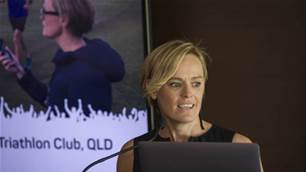Melissa Rollison has switched her name and her sport – and in astonishingly short order transformed into the current World 70.3 Triathlon champion.
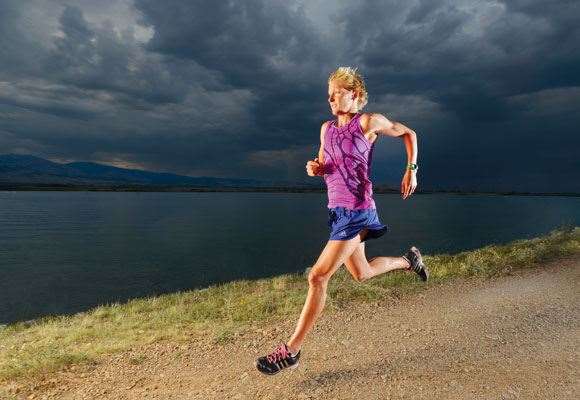 Photos by Timothy Carlson
Photos by Timothy CarlsonMelissa Rollison has switched her name and her sport – and in astonishingly short order transformed into the current World 70.3 Triathlon champion.
The name above might not yet mean much to most, but substitute “Melissa Rollison” and it ought to ring a few bells. One of Australia’s premier middle distance runners throughout the Noughties, Mel, 29, has not only chosen to amend her first name and change her second name (by taking the vows earlier this year with her husband, and physio, and coach, Jared Hauschildt), she’s also switched her sport – and in astonishingly short order transformed into the current World 70.3 (half-ironman) Triathlon champion.
It’s a remarkable story: having run throughout her teens (she was an out- standing junior, setting world records for steeplechase) and 20s, setting a welter of Australian senior records along the way, injuries forced her on to a bike so she could continue some kind of training to represent us in the steeplechase competition at the 2010 Commonwealth Games in Delhi (she’s a six-time Oz champ in the event). That quest was thwarted, but in the back end of that year, she tried her first tri – and won. What has followed has been an astonishing run of wins: she was undefeated throughout 2011 over numerous distances, culminating in the World title – this from an athlete who has never had a swim coach in her life.
Inside Sport spoke to her in Boulder, Colorado, where she was in training for her world title defence, a race she refers to simply as “Vegas”. At the time we went to press, that race was a week away ... We hope her new name DOES mean something to readers by now ...
PAIN, NO GAIN
“My fitness is pretty good right now. I had a stress fracture in my fibula, the lower outside of the leg, just before I came over here to Boulder, so I had to stop running for a month for it to heal. But I’ve been building my running back up now.
“It was only minor. The doctor said three weeks’ rest would be plenty, but I took four. Stress fractures aren’t new to me and I know coming back too soon could ruin my entire season. When I started running again the pain came back and I thought I’d stuffed it. I thought the stress fracture had returned, but it turned out to be tendonitis, which was the original injury ... So I had to take it easy for another month. That made my first few races tough – running 21km off the bike after only having done 20-minute easy jogs in training. But I’m all back into it now and it’s all good – no pain.
“I’m now running about 60-70km a week. That probably doesn’t sound like much – a runner would think I’m still building up with that mileage. But I’m nearly up to my full running. I was sitting on around 80km a week last year – I’m trying not to run as much now as I did as a pure runner because of all my injuries. I do a lot of my base work on the bike instead.”
ROUTINE
“Monday is my easier day. I just do two swim sessions and gym. Tuesday, I’ll have an easy ride in the morning of about 70-80km; I’ll then swim at 11 o’clock. In the afternoon, I do my hard run session – such as faster than race pace repetitions. Wednesday is a hilly ride up through the mountains in the morning, up to 120km, and then a 45 to 60-minute run off the bike. Then in the evening, I have swim squad. Thursday is like Tuesday in the morning, with just an easy run in the afternoon of about 45 minutes. Friday, I do my time trial-specific stuff on the bike in the morning – that means race-pace or above repetitions; I’ll usually cover around 100km including warm up and warm down. And then I do a run off the bike of up to 60 minutes, with around 20 minutes of that above race pace. Friday evening I swim. Saturday is my long ride, so that’s about 160-200km, with a 30-minute run off the bike, and then either a recovery swim in the evening or rest. Sunday is a long run, 90 minutes, and then a recovery ride in the evening. After all of that, there isn’t much time for anything else.”
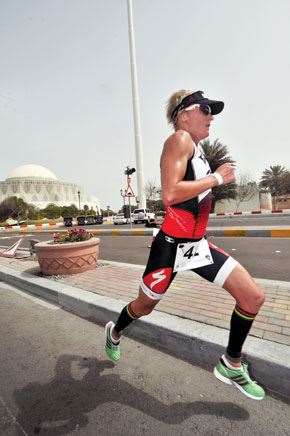 Photos by, Timothy Carlson
Photos by, Timothy CarlsonATHLETE TOWN
“In long course we have very little to do with Triathlon Australia. We’re all out on our own. But there’s a lot going on here in Boulder – it’s really good. I’m here with my husband; he’s pretty much my coach, so we just work out my program together – we do squad for swimming, but do our own bike and run. Sometimes on a Saturday I’ll jump in with some of the other guys for a long ride. Craig Alexander is here and lots of other athletes live here. It’s like athlete town.
“Why Boulder? The altitude and the location – you can go for a long ride and only go through maybe one traffic light. There’s no stopping – all the roads have massive, wide shoulders for the bikes. And the cars are so good anyway. It makes training a pleasure. At home I live in Brisbane; you go for a ride there and you’re stopping every 100 metres for traffic lights or roundabouts, and then you’ve got cars tooting you. But here, we’re on the edge of this tiny residential area with open fields and long, straight, quiet roads in every direction: you get on your bike and you can go for miles without stopping. There are so many great climbs – you can ride 30-40km straight up before you hit a descent, and there are great running trails right from our doorstep. It really is just the perfect training environment.
“Cars at home hate us. Last time I got home I was like, ‘Oh my god, I almost got killed out there!’ I’d forgotten about that.”
BEGINNINGS
“It’s not like sport was in the family – my whole family thinks I’m weird. I’m the odd one out. I was always active as a kid, and we were always doing outside things. When I was 11, I did the school cross country and I think I made it through to regionals and did all right there. Then someone suggested I should train for it, so I met up with my coach at that time, Brian Chapman. His coaching base was like a two-minute jog away from where I lived. I used to train with him twice a week and that’s how it all started.”
RUNNING
“I guess as a runner we are all a bit obsessive- compulsive – because you’ve only got one sport, you don’t want to miss a day. You might have a niggle, but you’re too afraid to take a day off, so you train through it. This is a reason why I really like triathlon now – if I’ve got the slightest little niggle, I can miss a run and jump on the bike, or jump in the pool, and I’m still training for my sport. But runners are kinda crazy – we always run through injuries and usually make them 100 times worse.”
“When I was training for the 2010 Comm Games, I got an injury, so I got a bike to keep training. But I still couldn’t get over it, so I joined the Wynnum Redlands Cycling Club and started riding with them. I did a few races and won. My manager is part of the club, and he suggested getting me into triathlon. I kept distancing myself, saying, ‘Nah, I can’t swim.’ That was true: I’d never done any swim training.
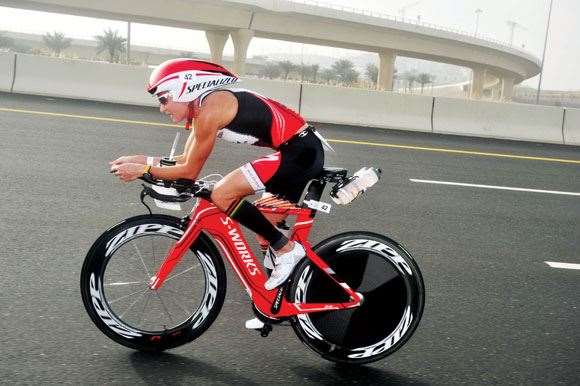 Photos by, Timothy Carlson
Photos by, Timothy Carlson“He kept trying to persuade me. He said, ‘But you can ride and run – you can always do long course.’ Eventually I did a duathlon and I won that, and then he’s like, ‘Come on, just try the swimming.’ So he took me down to the local pool, where he knew the tri coach. I started swimming there and thought, ‘Yeah, it’s not too bad.’ But I was no good at it. I’m still not great. That’s what I’ve really got
to work on. I think after this year I’m going to go home and find someone who can help me with stroke and everything. At the moment I just jump in with the squad and go as hard as I can, and the only reason I get anywhere is because I’m fit and I’ve got the determination. But my technique is terrible. I’m sure if I can get that figured out, I’ll go a lot quicker.
“I’ve never had any formal swimming training. I remember in primary school when we had swimming lessons, I used to get Mum to write me a note to get me out of it. I go back to Mum now and ask, ‘Why did you write that note!’ I’ve always loved the beach, but just not swimming.
“In my first couple of races, I was coming out of the swim dead-last by four or five minutes. And then I had to ride and run them down. I’ve definitely improved: I’m starting to come out about mid-pack now – but it’s still hard starting behind every time.
“At the World Championships last year, when I came out of the water I was still three minutes behind the leaders. The good thing is that, unlike Olympic distance triathlon, drafting isn’t allowed, so we all have to ride as hard as we can. If I get off the bike second or third, I can usually leave it to the run and catch most of them. But I get frustrated that I can’t swim well.
“It’s never a chore to get on the bike or go for a run. But swimming, yeah, it’s a bit boring. Doing it in a squad is a lot better – when you’re being told what to do. Just to have the coach standing there: ‘Do 100, now do 200.’ It makes it a lot easier and makes it go a lot quicker. I’ve improved a lot, so that makes it more interesting. But at home I swim with 11-year-old kids and they fly past me! I’m like: ‘I’ve got to be fitter, I have to
be stronger, how is this happening?’ I’ve always been used to working harder or working longer to improve, but it’s not about that – it’s all about technique and skill.
“In fact, I actually prefer the bike to running now – you can go further, and faster. You see more. But swimming? All you’re doing is looking at a black line.”
DOWN THE HATCH
“I’m training so much now, I basically have to eat as much as I can. With running, you could never eat before training or competing; you only eat after, and you try and eat as little as possible to stay really thin. But now that I’m out on the bike for five or six hours, then have to get off and do a run, you have to eat before, during and after. Long-course athletes don’t worry about weight so much – it’s more about how much food you have to get in, in order to recover properly so you can back up the next day. Jared’s always on my case. As soon as I get in the door, he’s got a protein shake for me. He’s a strict believer in eating within 15 minutes of finishing a session.
“The only time I struggle to eat is after a hard running session. It’s the same as after a race: I can’t eat, so I try to get shakes in or lollies or cookies. It’s always easier to down refined sugar immediately after a race; although it’s not the healthiest, it’s better than nothing.
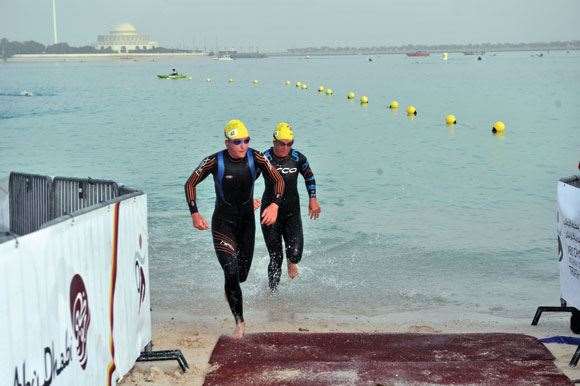 Photos by, Timothy Carlson
Photos by, Timothy Carlson“We pretty much eat a general diet – lots of fruit and veg. Lots of red meat, though, especially if I’m here in Boulder because you lose iron at a greater rate at altitude.
“I’m fortunately sponsored by SIS, Science In Sport. I eat their bars and gels, protein and electrolytes. That saves a bit of money because you go through a lot on the bike. Sometimes I make a peanut butter sandwich for the ride, but it’s so much easier to chuck bars in your pockets. Sometimes you get back from training and think, ‘Oh, what can I eat?’ Just today, I started scooping peanut butter out of a jar with a teaspoon ...
“I take liquid iron when I’m performing at altitude, but other than that, no supplements or potions.”
CROSS TRAINING?
“With triathlon, I never have to do anything active other than my sport. Though, I do ride my skateboard a bit in the off-season. I’ve got a long board and a short board, so it depends where I go. My coach doesn’t really like it – but when we’re in full training, there’s not really any time to do anything more active. You’re too buggered.”
ON YOUR FEET
“I’m sponsored by Adidas. I think they’re one of the best brands – and I’m not just saying that because I’m sponsored by them. I’m pretty picky with my shoes. When I went to triathlon, I had a lot of shoe sponsors come to me. All those new, weird and whacky ‘triathlon’ ones. I said to my manager, ‘Adidas or Nike.’ I don’t care how much money they’re offering – I’ve had so many injuries from incorrect footwear. I just want an old-school basic shoe. The good thing about Adidas, there’s nothing fancy. No big air bags here, gel there and all this sort of stuff – just a simple, plain shoe. I like good cushioning, but not all the plastic and the extra support for pronating, supernating, etc. I’m a forefoot striker, so this is of no use to me. I just need some cushioning.”
HEAD SPACE
“I don’t listen to music at all when I’m training. I don’t like it. It relaxes me too much – it chills me out. I like to be in the moment – especially when I’m doing the hard sessions. I like to ... I don’t know ... feel the pain, I guess ... The good times and the bad times.”
TECH HEAD?
“I’m not a gadget person. No heart-rate monitor, no Wattage. Nothing like that. I have just the basic watch for running – just time, no GPS or anything. On my bike, I just look at the speed. And the altitude: I like to know how high I’m climbing. Just for interest.”
GETTING UP
“During the racing season, I never have a problem with motivation; because you’ve always got a race ahead of you every two to four weeks, you’ve always got that to focus on – it’s the goal. I guess the hardest time is in the off-season, when I’m home, when it’s cold, stuff like that. It might be 4.30 in the morning and you’ve got to get out of bed and it’s dark and cold – that’s the hard bit. But you just pull yourself together; that’s when you think, ‘My competitors are out there training – I’d better get up.’ Generally, there’s not much of a problem with motivation because you’ve got three disciplines – it mixes it up and makes it interesting.
“The thrill of winning is probably what keeps us all going – especially winning the world champs. All that hard work has paid off – I guess that’s what you’re thinking.
“During a race, if I’m starting to slacken off, I just think, ‘Well, if I slacken off, it means it’s going to hurt a lot longer than if I keep pushing through this bit of pain.’ If I don’t win a race, if I’m not the strongest in the field and the other girls are better than me, I can accept that, but if I’ve slackened off or done something wrong in a race, it plays on my mind for weeks. I can’t live it down. That’s what I think about when I’m really hurting. It’s only a little bit of pain now – it’ll all be worth it.”
‒ Graem Sims
Related Articles
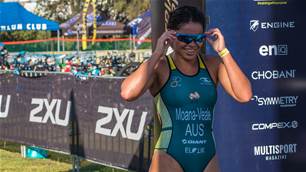
Moana-Veale to give her all to make Tokyo 2020
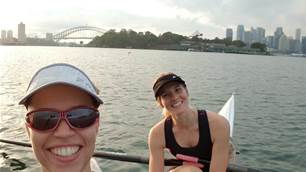
Molenaar's giving back to the sport she loves
